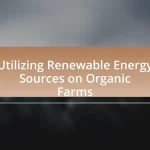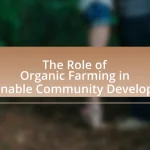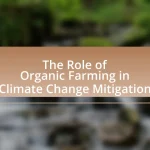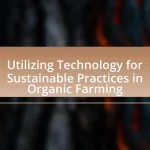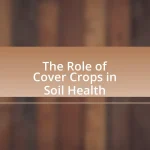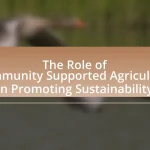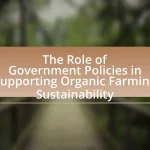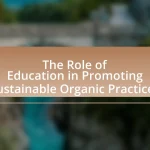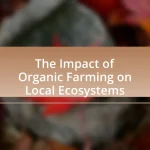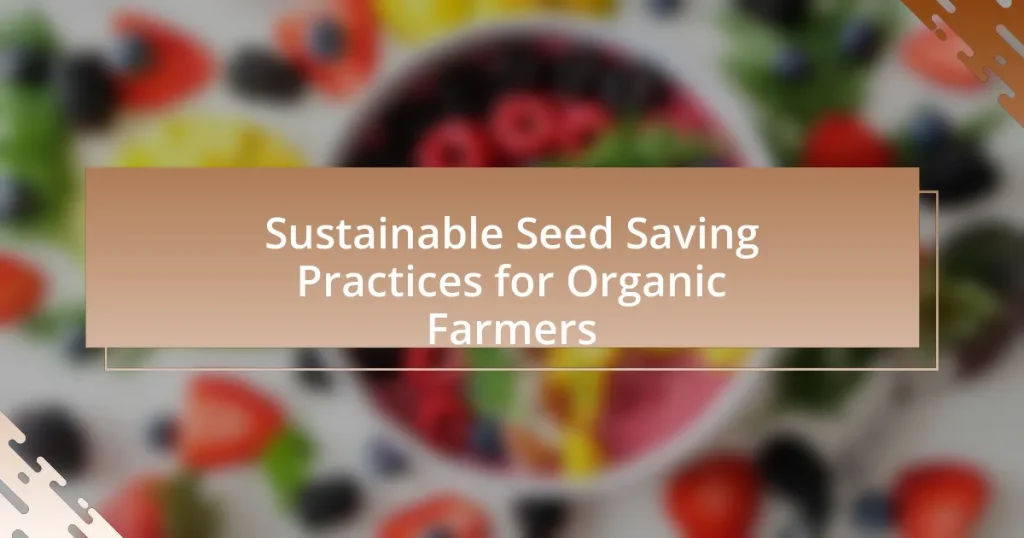Sustainable seed saving practices for organic farmers focus on selecting seeds from healthy plants, maintaining genetic diversity, and employing proper storage techniques. These practices enhance resilience against pests and diseases, promote biodiversity, and reduce reliance on commercial seed sources. Key principles include local adaptation, seed purity, and the importance of preserving a diverse gene pool. Challenges such as seed viability and legal restrictions are addressed, along with strategies for effective seed saving, including proper storage and community networks for seed sharing. Resources and organizations supporting seed saving initiatives are also highlighted, providing farmers with essential tools for sustainable agriculture.
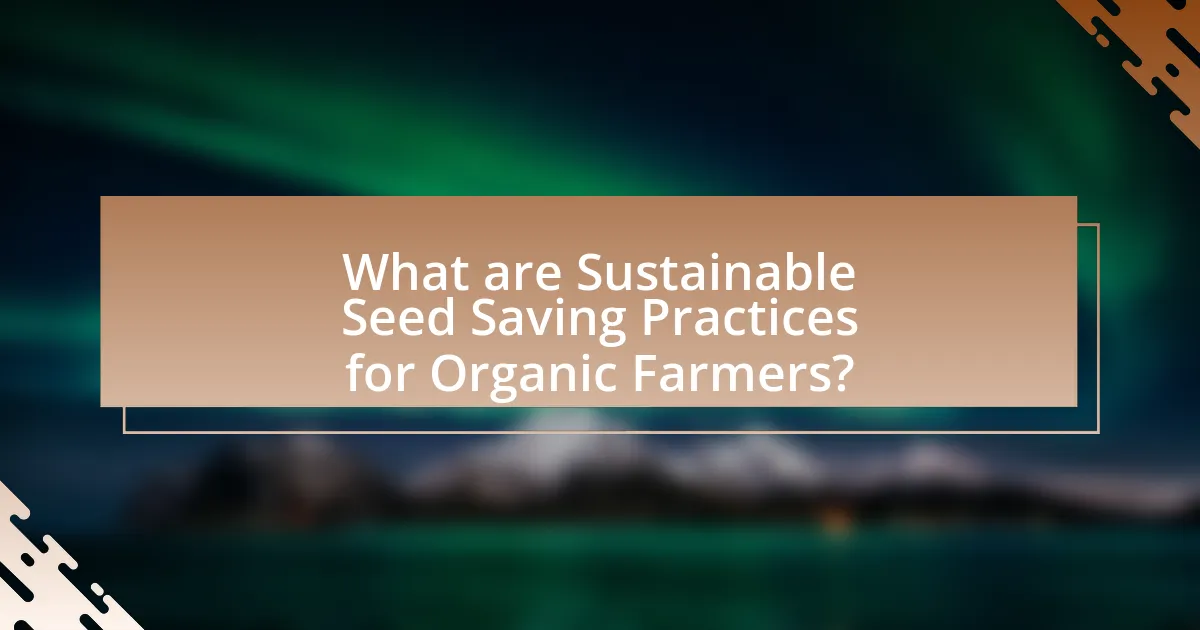
What are Sustainable Seed Saving Practices for Organic Farmers?
Sustainable seed saving practices for organic farmers include selecting seeds from the healthiest plants, ensuring genetic diversity, and using proper storage techniques. Organic farmers prioritize seeds that are adapted to their local environment, which enhances resilience and reduces dependency on external seed sources. Additionally, maintaining genetic diversity through the cultivation of multiple varieties helps safeguard against pests and diseases. Proper storage methods, such as keeping seeds in a cool, dry place, further ensure seed viability for future planting. These practices are essential for promoting biodiversity and sustainability in organic farming systems.
Why is seed saving important for organic farming?
Seed saving is important for organic farming because it promotes biodiversity and enhances resilience against pests and diseases. By preserving seeds from well-adapted plants, organic farmers can maintain a diverse gene pool, which is crucial for adapting to changing environmental conditions. Research indicates that diverse crops can lead to improved yields and reduced reliance on chemical inputs, aligning with organic farming principles. Additionally, seed saving fosters self-sufficiency, allowing farmers to reduce costs associated with purchasing seeds annually, thereby supporting sustainable agricultural practices.
What role does seed saving play in biodiversity conservation?
Seed saving plays a crucial role in biodiversity conservation by preserving genetic diversity within plant species. This practice allows farmers and communities to maintain a wide variety of crops, which is essential for adapting to changing environmental conditions and combating pests and diseases. For instance, the Seed Savers Exchange reports that seed saving has helped preserve over 25,000 varieties of fruits and vegetables, contributing to the resilience of agricultural systems. By maintaining diverse seed stocks, seed saving supports ecosystem stability and enhances food security, ensuring that future generations have access to a rich variety of crops.
How does seed saving contribute to sustainable agriculture?
Seed saving contributes to sustainable agriculture by preserving genetic diversity and reducing dependency on commercial seed sources. This practice allows farmers to select seeds that are best adapted to their local environment, enhancing resilience against pests and diseases. Research indicates that diverse seed varieties can improve crop yields and soil health, as seen in studies conducted by the Food and Agriculture Organization, which highlight that maintaining a variety of seeds can lead to more sustainable farming systems. Additionally, seed saving promotes self-sufficiency among farmers, reducing costs associated with purchasing seeds annually and fostering a more sustainable agricultural economy.
What are the key principles of sustainable seed saving?
The key principles of sustainable seed saving include biodiversity preservation, genetic diversity maintenance, and local adaptation. Biodiversity preservation ensures a wide variety of plant species and varieties are maintained, which is crucial for ecosystem resilience. Genetic diversity maintenance within seed populations helps protect against diseases and pests, as diverse genetic traits can provide resistance. Local adaptation refers to selecting and saving seeds from plants that thrive in specific local conditions, enhancing their suitability for future cultivation in those environments. These principles are supported by practices such as selecting seeds from the healthiest plants, avoiding hybrid seeds that cannot be saved, and using organic methods to cultivate and store seeds, which align with sustainable agricultural practices.
How can organic farmers select the best seeds for saving?
Organic farmers can select the best seeds for saving by choosing varieties that are well-adapted to their local climate and soil conditions. This involves evaluating the performance of different seed varieties over multiple growing seasons, focusing on traits such as disease resistance, yield, and flavor. Research indicates that seeds from plants that exhibit strong growth and resilience in the farmer’s specific environment are more likely to produce successful crops in the future. Additionally, farmers should prioritize open-pollinated or heirloom varieties, as these can be saved and replanted without losing their genetic traits, ensuring sustainability and biodiversity in their farming practices.
What methods can be used to ensure seed purity?
To ensure seed purity, methods such as isolation, careful selection, and testing can be employed. Isolation involves physically separating different plant varieties to prevent cross-pollination, which is crucial for maintaining genetic integrity. Careful selection of parent plants based on desirable traits further enhances purity, as it allows farmers to choose the best specimens for seed production. Additionally, testing seeds for genetic purity through laboratory analysis can confirm that the seeds meet specific purity standards. These practices are supported by research indicating that maintaining seed purity is essential for crop quality and yield, as demonstrated in studies on organic farming practices.
What challenges do organic farmers face in seed saving?
Organic farmers face several challenges in seed saving, primarily including seed viability, genetic diversity, and legal restrictions. Seed viability can be compromised due to improper storage conditions or pests, leading to reduced germination rates. Genetic diversity is often limited because many organic farmers rely on a narrow selection of seeds, which can increase vulnerability to diseases and pests. Additionally, legal restrictions, such as patents and intellectual property rights on certain seed varieties, can hinder farmers’ ability to save and share seeds. These challenges are supported by studies indicating that a lack of access to diverse seed sources can negatively impact organic farming sustainability and resilience.
How can farmers overcome issues related to seed viability?
Farmers can overcome issues related to seed viability by implementing proper seed storage techniques and selecting high-quality seeds. Proper storage involves maintaining optimal temperature and humidity levels to prevent seed deterioration; for instance, seeds should be stored in a cool, dry place, ideally at temperatures below 15°C and humidity levels below 8%. Additionally, farmers should choose seeds that have been tested for germination rates, as seeds with a germination rate above 85% are generally considered viable. Research indicates that using seeds from well-adapted local varieties can also enhance viability, as these seeds are more resilient to local environmental conditions.
What are the legal considerations for seed saving?
Legal considerations for seed saving include understanding intellectual property rights, particularly plant variety protection laws and patents. In many jurisdictions, seeds from patented plants cannot be saved and replanted without permission from the patent holder. Additionally, some seeds may be protected under the UPOV (International Union for the Protection of New Varieties of Plants) convention, which restricts the rights of farmers to save and reuse seeds of protected varieties. Furthermore, compliance with local regulations regarding the sale and distribution of seeds is essential, as some regions require seed certification to ensure quality and prevent the spread of diseases. Understanding these legal frameworks is crucial for organic farmers to avoid potential legal issues while practicing sustainable seed saving.
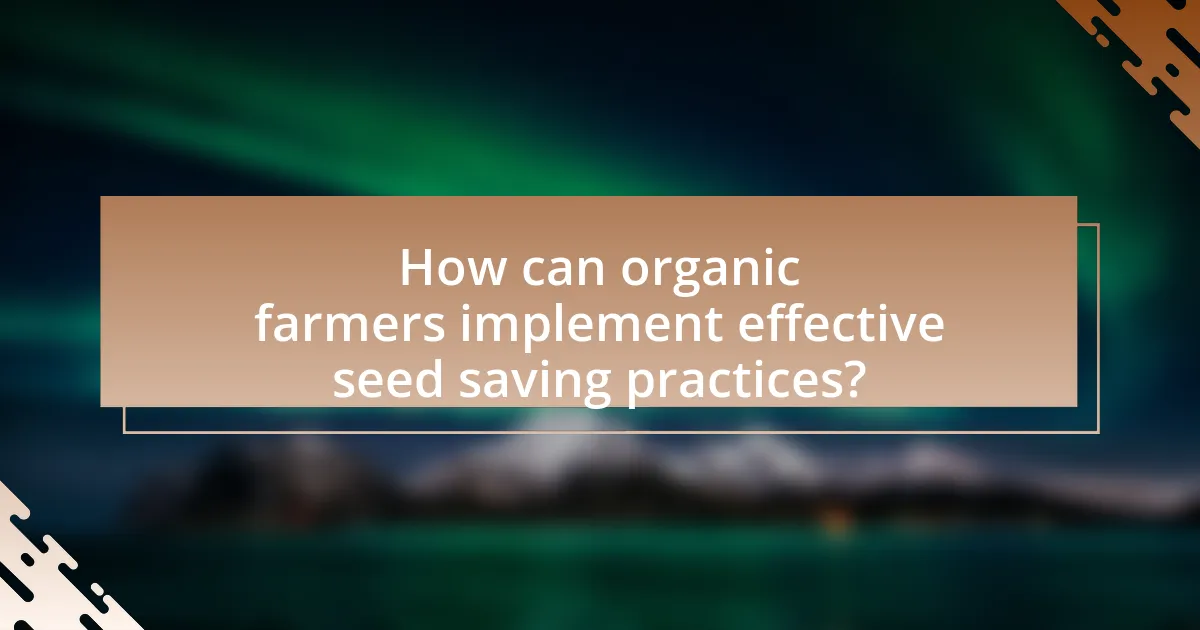
How can organic farmers implement effective seed saving practices?
Organic farmers can implement effective seed saving practices by selecting seeds from the healthiest and most productive plants, ensuring genetic diversity, and properly storing seeds in a cool, dry environment. By choosing seeds from plants that exhibit desirable traits, farmers can enhance the quality of future crops. Maintaining genetic diversity is crucial, as it helps in adapting to changing environmental conditions and pest pressures. Proper storage techniques, such as using airtight containers and controlling humidity, can significantly extend seed viability. Research indicates that seeds saved from well-adapted plants can lead to improved yields and resilience, supporting sustainable agricultural practices.
What techniques are recommended for seed saving?
Recommended techniques for seed saving include selecting seeds from healthy, mature plants, ensuring genetic diversity by saving seeds from multiple plants, and properly drying and storing seeds in a cool, dark, and dry environment. These practices help maintain seed viability and prevent the loss of genetic traits. Research indicates that seeds saved from well-adapted plants can lead to improved crop resilience and yield, supporting sustainable agriculture.
How can farmers properly store seeds for long-term viability?
Farmers can properly store seeds for long-term viability by ensuring they are kept in a cool, dry, and dark environment. This method minimizes moisture and temperature fluctuations, which can lead to seed deterioration. For instance, seeds should be placed in airtight containers, such as glass jars or vacuum-sealed bags, to protect them from humidity and pests. Additionally, maintaining a storage temperature between 32°F and 41°F (0°C to 5°C) can significantly extend seed life, as research indicates that lower temperatures slow down the aging process of seeds. Proper labeling with the date of storage and seed variety also aids in tracking viability over time.
What are the best practices for seed cleaning and processing?
The best practices for seed cleaning and processing include thorough drying, proper sorting, and effective cleaning techniques. Thorough drying prevents mold and seed deterioration, ensuring seeds remain viable. Proper sorting involves removing damaged or non-viable seeds, which enhances overall seed quality. Effective cleaning techniques, such as using air screens and seed cleaners, remove debris and impurities, further improving seed purity. Research indicates that these practices can increase germination rates and seed longevity, making them essential for sustainable seed saving in organic farming.
How can farmers ensure genetic diversity in their saved seeds?
Farmers can ensure genetic diversity in their saved seeds by selecting seeds from a wide variety of plants within the same species and by practicing crop rotation. This approach allows for the preservation of different genetic traits, which enhances resilience against pests and diseases. Research indicates that maintaining a diverse gene pool can improve crop yields and adaptability to changing environmental conditions. For instance, a study published in the journal “Agricultural Systems” highlights that diverse seed populations can lead to better overall performance in variable climates, confirming the importance of genetic diversity in sustainable agriculture.
What strategies can be employed to maintain diverse seed stocks?
To maintain diverse seed stocks, organic farmers can implement strategies such as practicing seed saving from a wide variety of crops, ensuring genetic diversity through cross-pollination, and utilizing seed banks for preservation. Seed saving from multiple varieties allows farmers to adapt to changing environmental conditions and pests, while cross-pollination enhances genetic variability, which is crucial for resilience. Additionally, seed banks, such as the Svalbard Global Seed Vault, provide a backup for preserving genetic diversity, safeguarding against loss due to climate change or disasters. These strategies collectively support the sustainability and adaptability of agricultural systems.
How does crop rotation affect seed diversity?
Crop rotation enhances seed diversity by promoting a variety of crops in a given area over time, which helps maintain genetic diversity within plant populations. This practice reduces the risk of pest and disease outbreaks that can occur when the same crop is planted repeatedly, as diverse crops can disrupt pest life cycles and reduce their populations. Research indicates that farms employing crop rotation can see an increase in the number of seed varieties cultivated, leading to a more resilient agricultural system. For example, a study published in the journal “Agriculture, Ecosystems & Environment” found that crop rotation significantly increased the diversity of both crops and associated soil microorganisms, which are crucial for plant health and productivity.
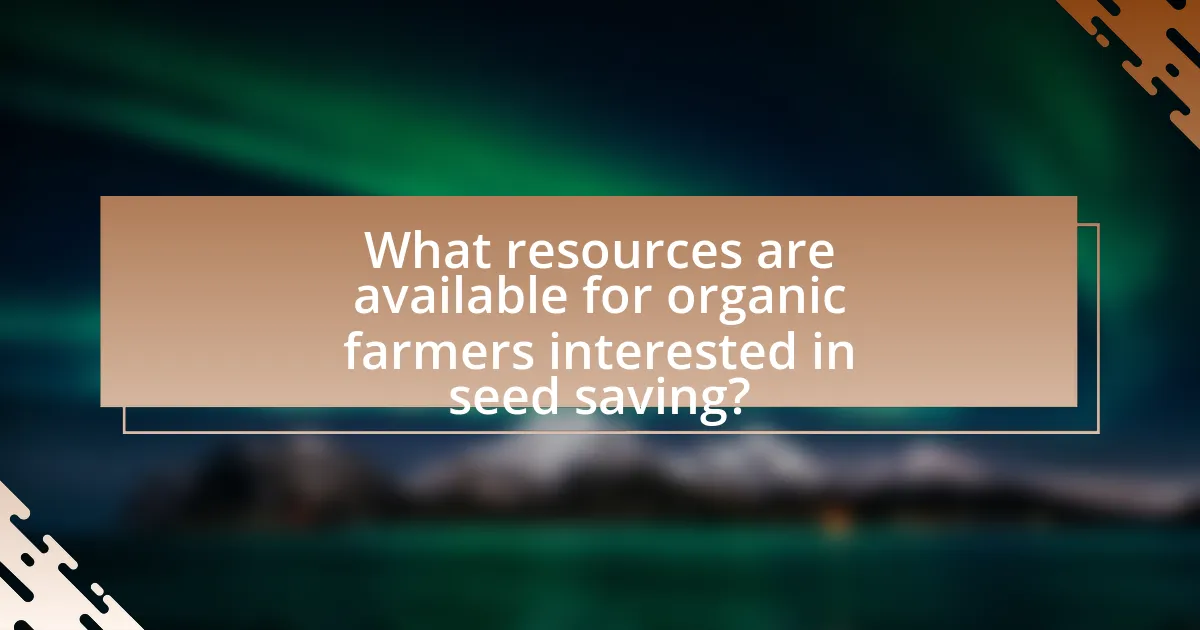
What resources are available for organic farmers interested in seed saving?
Organic farmers interested in seed saving can access a variety of resources, including seed saving organizations, educational workshops, and online databases. Organizations such as Seed Savers Exchange provide extensive information on heirloom seeds and offer a platform for farmers to exchange seeds. Educational workshops, often hosted by local agricultural extension services or community colleges, teach techniques for seed saving and plant breeding. Additionally, online databases like the USDA’s National Plant Germplasm System offer access to a wide range of seed varieties and their characteristics, supporting farmers in selecting appropriate seeds for their specific conditions. These resources collectively enhance the knowledge and skills necessary for effective seed saving in organic farming.
What organizations support seed saving initiatives?
Organizations that support seed saving initiatives include Seed Savers Exchange, which focuses on preserving heirloom seeds and promoting biodiversity. Additionally, the Organic Seed Alliance advocates for organic seed production and offers resources for seed saving practices. The Center for Food Safety works on policy advocacy to protect seed diversity and promote sustainable agriculture. These organizations provide educational resources, community support, and advocacy efforts to enhance seed saving practices among farmers and gardeners.
How can farmers access educational materials on seed saving?
Farmers can access educational materials on seed saving through various resources such as agricultural extension services, online platforms, and community workshops. Agricultural extension services often provide printed materials, workshops, and one-on-one consultations to educate farmers on best practices for seed saving. Online platforms, including websites of organizations like Seed Savers Exchange and the USDA, offer comprehensive guides, videos, and articles on seed saving techniques. Additionally, local agricultural cooperatives and universities frequently host community workshops that focus on sustainable seed saving practices, allowing farmers to learn directly from experts and share knowledge with peers.
What community networks exist for seed sharing among farmers?
Community networks for seed sharing among farmers include Seed Savers Exchange, which connects farmers to share heirloom seeds, and the Open Source Seed Initiative, promoting the sharing of seeds under open-source licenses. Additionally, local seed libraries and community-supported agriculture (CSA) programs facilitate seed exchange among local farmers. These networks enhance biodiversity and support sustainable agricultural practices by allowing farmers to access a diverse range of seeds while preserving traditional varieties.
What practical tips can enhance seed saving success for organic farmers?
To enhance seed saving success for organic farmers, it is essential to select seeds from healthy, well-adapted plants that exhibit desirable traits. This practice ensures that the saved seeds are more likely to thrive in similar environmental conditions. Additionally, farmers should practice proper seed storage techniques, such as keeping seeds in a cool, dry place to maintain viability. Research indicates that seeds stored at lower temperatures and humidity levels can retain their germination rates for longer periods. Furthermore, organic farmers should maintain detailed records of seed sources, planting dates, and performance to inform future seed selection and improve overall success rates.
How can farmers create a seed saving plan tailored to their needs?
Farmers can create a seed saving plan tailored to their needs by assessing their specific crop requirements, selecting appropriate seed varieties, and establishing a systematic collection and storage process. First, farmers should evaluate the crops they grow, considering factors such as climate, soil type, and pest resistance, to choose seed varieties that perform best in their conditions. Next, they should implement a collection schedule aligned with the maturity of their crops, ensuring seeds are harvested at optimal times for quality and viability. Finally, proper storage techniques, including maintaining low humidity and stable temperatures, are essential to preserve seed integrity over time. Research indicates that effective seed saving can enhance biodiversity and reduce dependency on commercial seed sources, contributing to sustainable agricultural practices.
What common mistakes should be avoided in seed saving practices?
Common mistakes to avoid in seed saving practices include saving seeds from hybrid plants, which can lead to unpredictable traits in future generations. Additionally, improper storage conditions, such as high humidity or temperature fluctuations, can reduce seed viability. Failing to properly label seeds can result in confusion and misidentification, impacting future planting decisions. Lastly, neglecting to select seeds from healthy, vigorous plants can compromise the quality of the saved seeds, as they may inherit diseases or weaknesses. These practices are essential for maintaining the integrity and sustainability of seed saving efforts.
